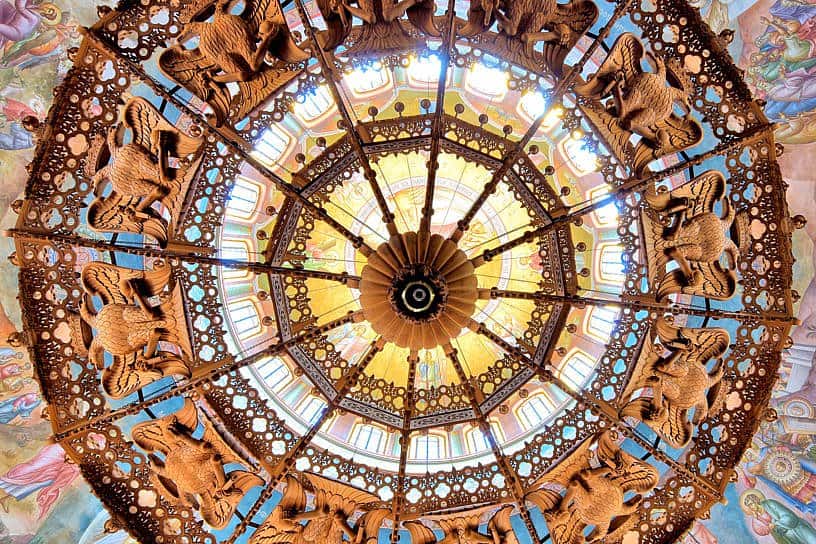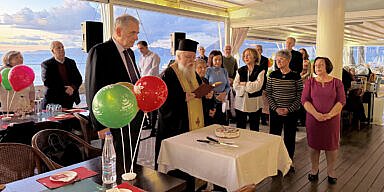It took 66 long years to build the Saint Andrews’ Church, from the initial groundbreaking of 1908 until the building was finished, in 1974. Its imposing design and outstanding architecture of this, one of the largest and finest Churches in the Balkans, is a magnet for visitors, as well as the faithful, in Patra, Greece. It was indeed a moving moment, for me, to be able to depict the venerated space and to realize that one is, in spirit at least, next to one of the founders and martyrs of Christianity.
We discussed its construction in a previous article. Let’s now look at the interior:
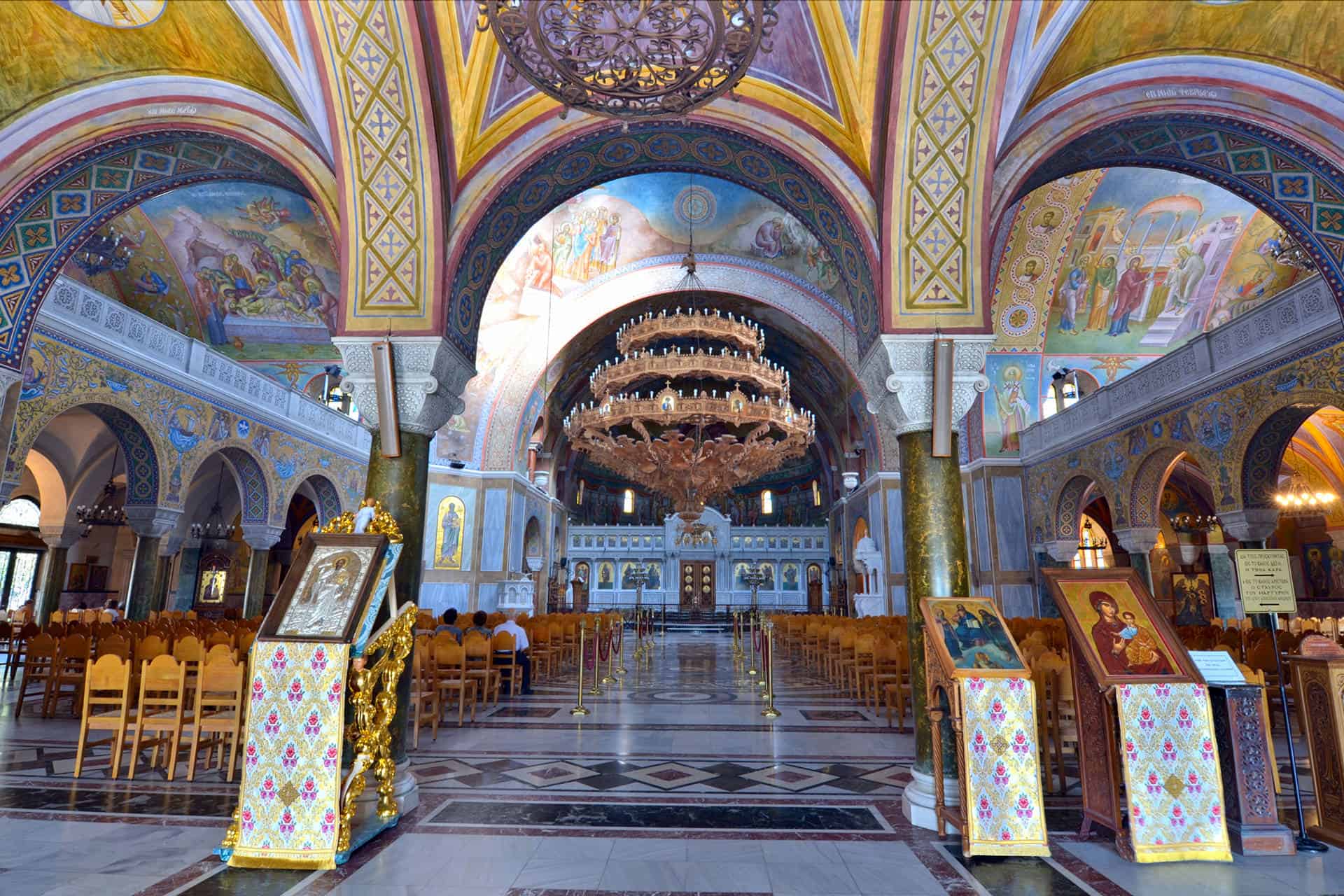
Entrance through the Narthex
Entering beyond the narthex, the visitor is immediately stunned by the sight of its immense, low-hung chandelier, that seems to float just above our heads below the magnificent, tall central dome. It is made mostly of wood. Made of three tiers of 12 segments each, each magnificently carved into the Byzantine double-headed eagle and complimentary decorations, festooned with 144 lamps, it is suspended at a commanding place above the crossing, at the center of the nave.
The central chandelier is part of the interior finishing of the building, which started in with the painting (1989 -1992) and finished with the mosaics (1995 – 2006).
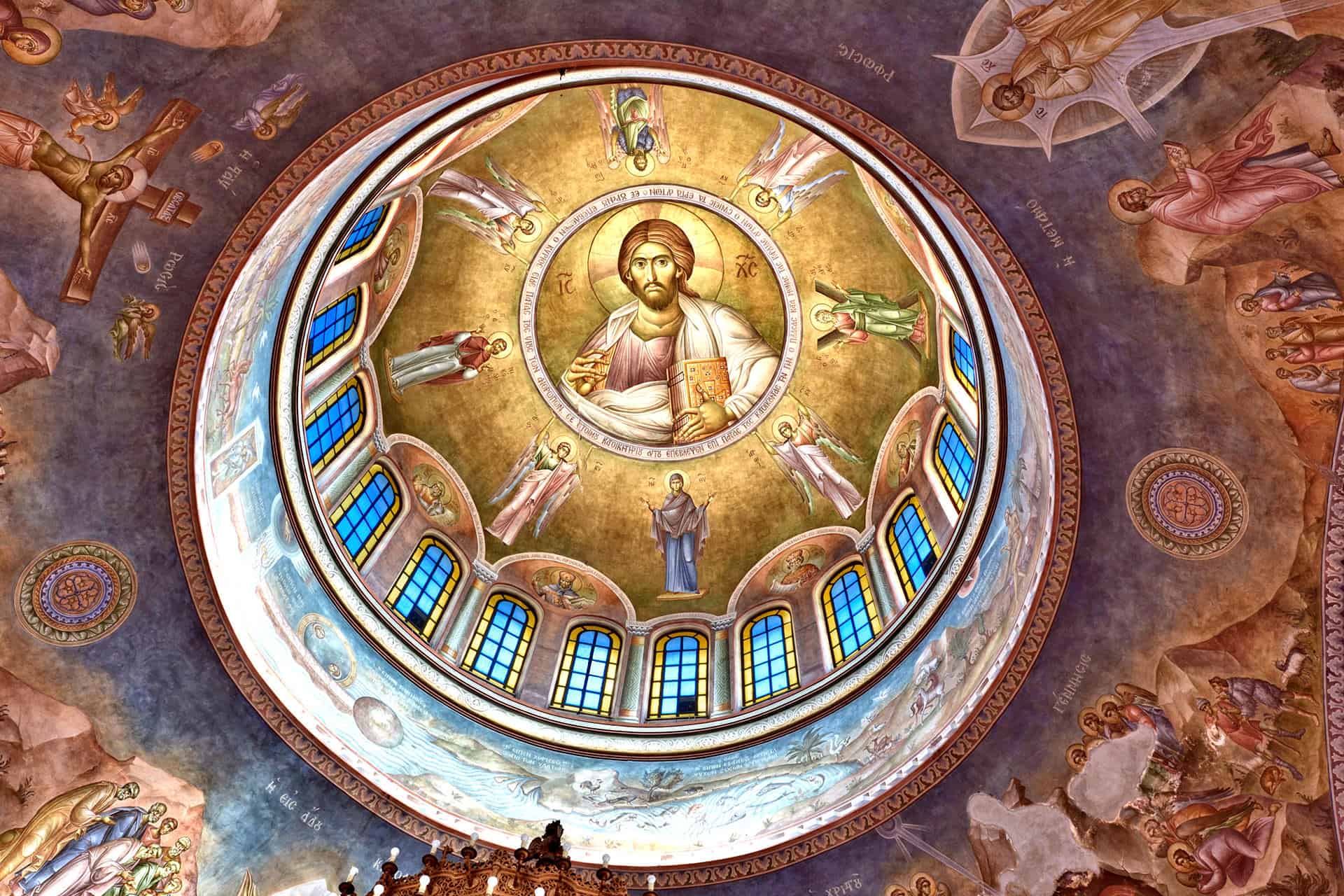
The Dome with Christ Pantocrator
Far, far above the chandelier is the traditional depiction of Christ Pantocrator, looking at the assembly below with a peaceful look of love and benevolence. He was painted by Ioannis Karousas, who was selected by a committee that included, besides clerics, also artists and architects of name and position, who coordinated, worked with, advised, and approved the designs before the execution started. The exceptionally large head of Christ is 2.45 meters (8 ft.,) the nose alone is 0.70 meters (2.3 ft,) but it’s so high – nearly 35 meters from the floor – that He seems of human scale.
This was a particularly tall dome, with high sides, so it was decided to “fill” these almost vertical side areas above the dome windows with a set of Saints, to match the stained glass windows of the structure. So this space is filled with the dance of Angels and Saints. Karousos also painted the remainder of the work in the entire Church and graciously acknowledged the help in the design to the committee members.
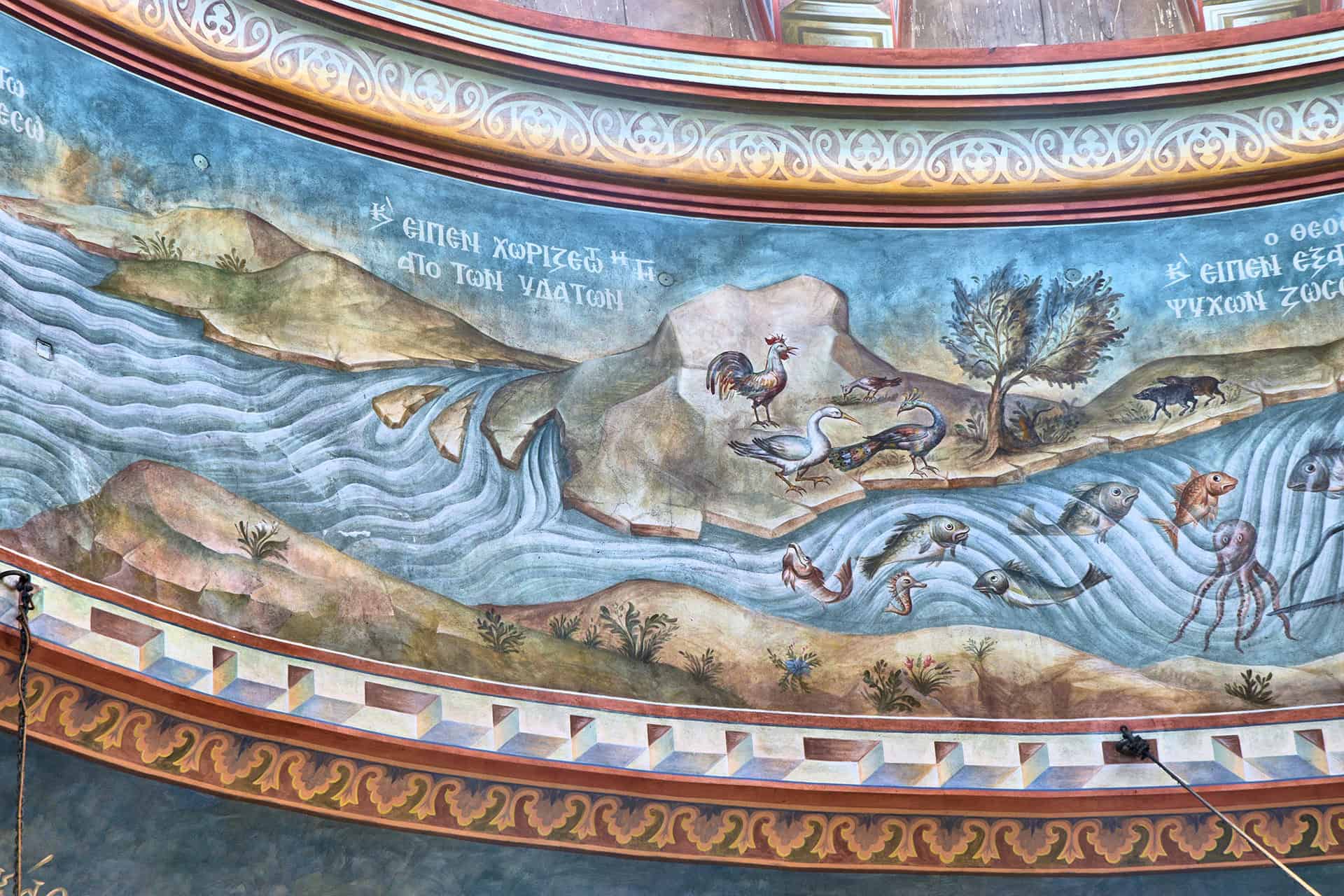
Detail of Creation
Immediately below the windows is the circular barrel, which is in effect a ring 3.10 meters (10.7 ft) high, and 45.5 meters (149.3 ft) in circumference, is adorned with depictions of the Creation of the World (The first 7 days described in the Holy Bible). A small portion of the ring, viewed here, depicts the separation of the land from the waters.

View of Ieron
Our sight is then attracted by the traditional depiction of Panagia Platytera, in the also traditional semi-spherical dome over the Apse. By Byzantine stylism, the Virgin Mary spreads her arms to protect the faithful. Her icon is also very large, being 5.75 meters (43.2 ft) in size, and her head alone is 1.85 meters (6.0 ft.).
The Apse of this Church is much larger in comparative scale than in most other Churches, so it presented an aesthetic problem, brilliantly solved by the artist and his guiding committee: To fill the sizable space below the Virgin, the city of Patra – as seen from the sea – was depicted, including the building of the Church itself! The depiction of a city was a unique concept, and the effect, below the stunning Virgin and Child Jesus, is truly an inspiring success.
(It’s not unusual to find critics of aesthetic and cultural work, however. In the case of the depiction of the City of Patra, Mr. Karousas informs us that at the time, a group of Monks from Agion Oros registered their objection, on the basis of lack of precedent, but it was – wisely – overruled.)
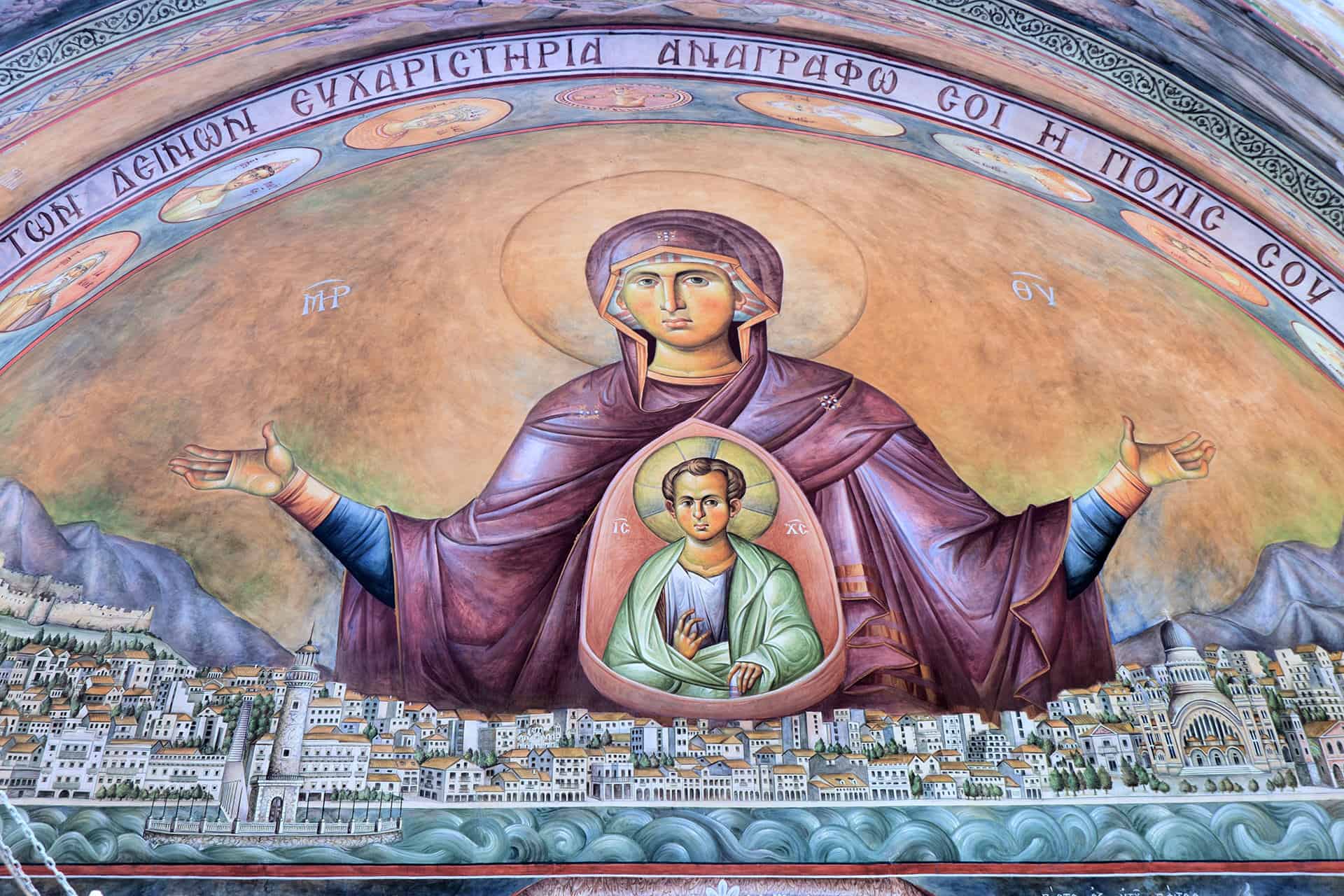
Platytera Protectress of Patra
It is interesting to note that, besides the superb rendering of the Virgin and Child Jesus, the depiction of the city itself is a faithful view of the harbor and central area as it existed when the work was completed. On the left, is the “Faros,” or Lighthouse, a traditional landmark of the harbor, before it was relocated to a city park further West, to make room for larger ships to enter the harbor. On the right is a detailed view of the St. Andrews Church building itself – a truly unique concept of the interior of a Church to graphically depict its exterior! And on the far left, the old fort on the hill, which dates from ancient times, but was built in its present form in the 6th Century, is also in view. Older citizens of Patra can identify individual buildings, including other Churches, in this glorious rendering.
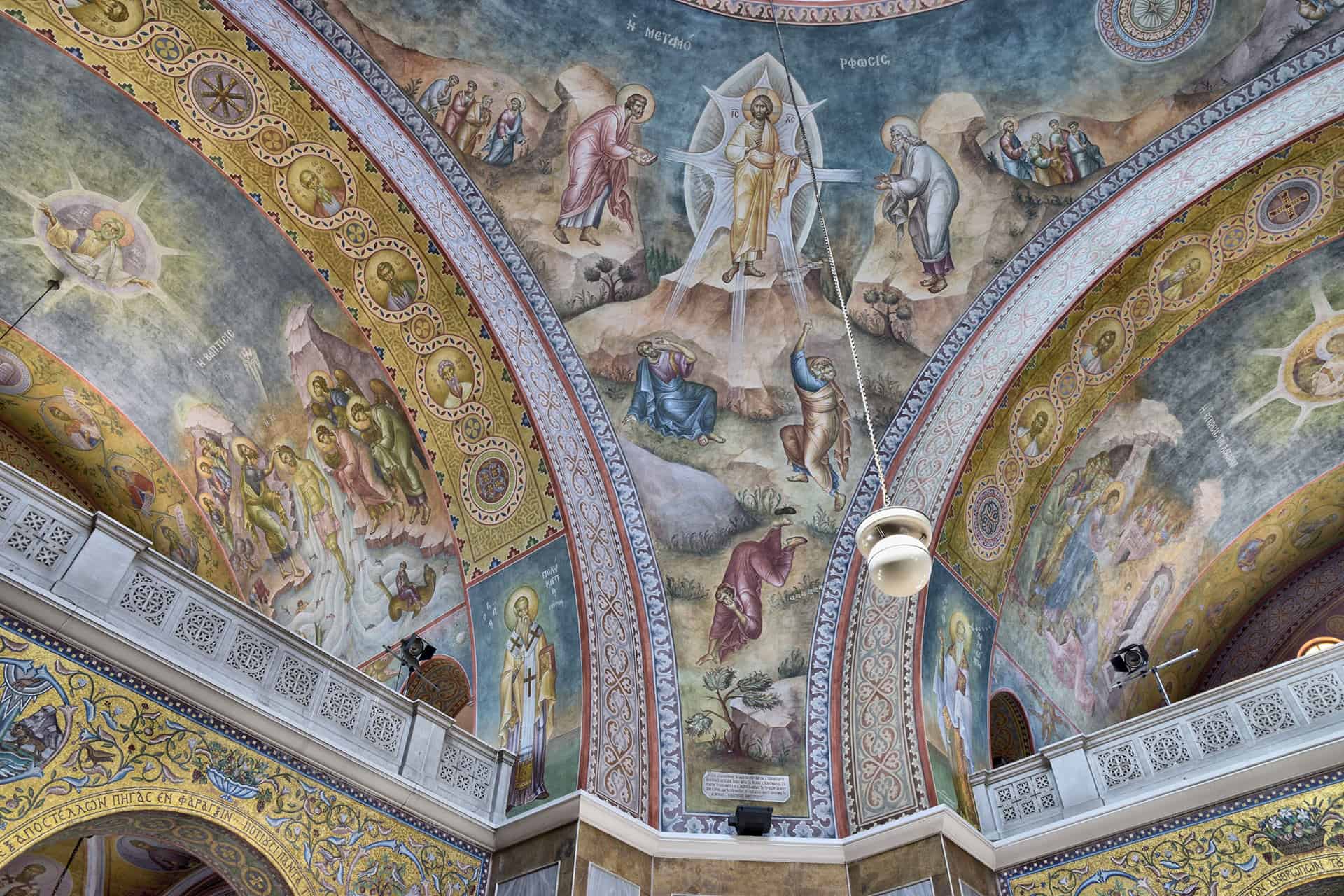
Pendentive – Metamorfosis
We then look at the interior of the four massive pillars that support the dome. These spaces (“pendentives”) are curving inwards, and triangular in shape, widening at the top. The artist painted these pillars with four scenes in matching quality and sense, here depicting Christ’s birth, Metamorphosis, Crucifixion, and Resurrection. This pillar depicts the Metamorphosis. The style is, of course, Byzantine throughout the work.
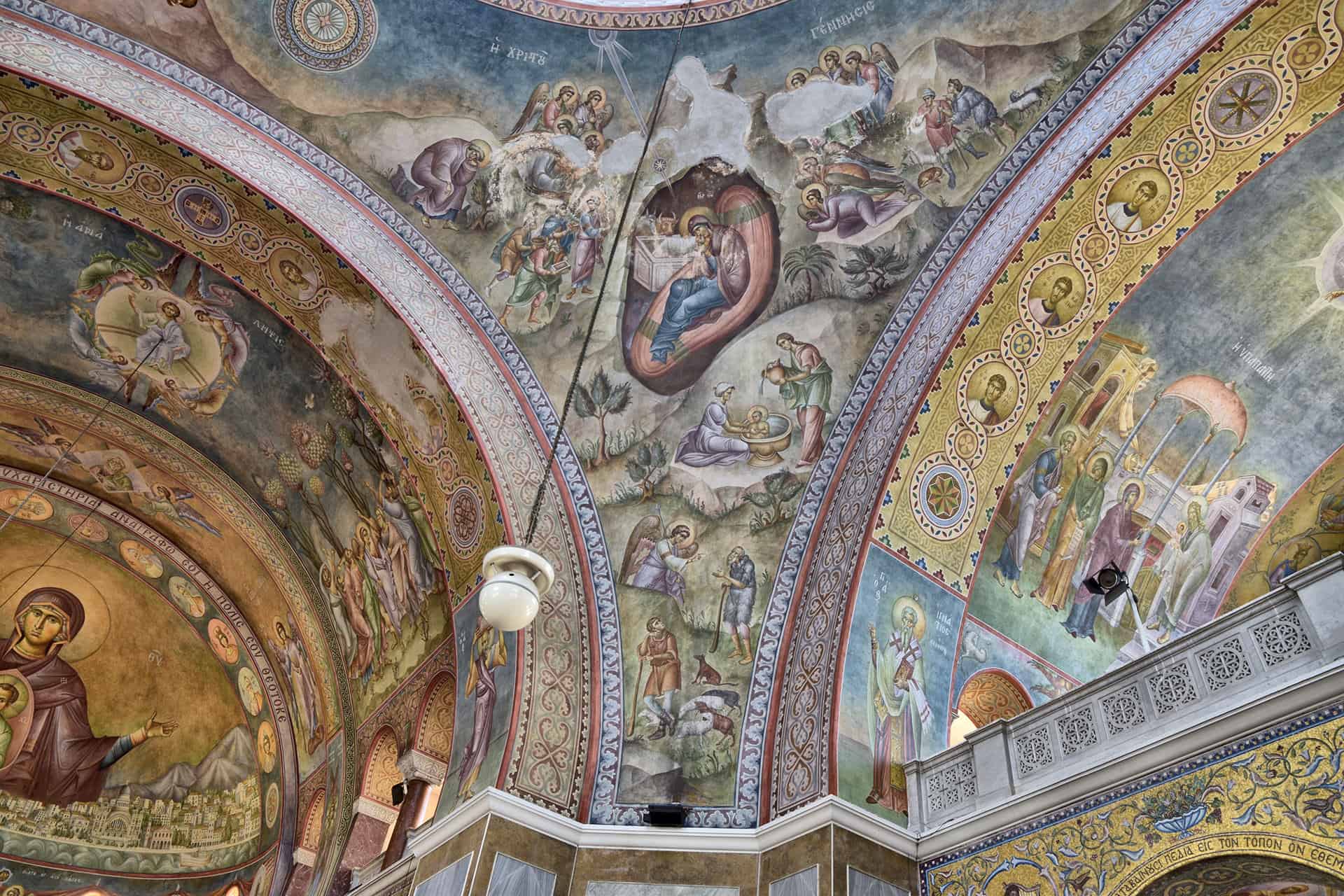
Pendentive – Christ’s Birth
It was decided that the best way to paint these decorations -throughout – was not to paint “al-fresco,” – that is, directly onto fresh plaster – but to use a more modern method – widely used today, which involves painting the scenes on canvas, which is then cemented onto the walls. The advantages of this method are enormous, and time has proven this technique to be both successful and long-lasting., although some water-damage can be discerned above the rendering of the cave.
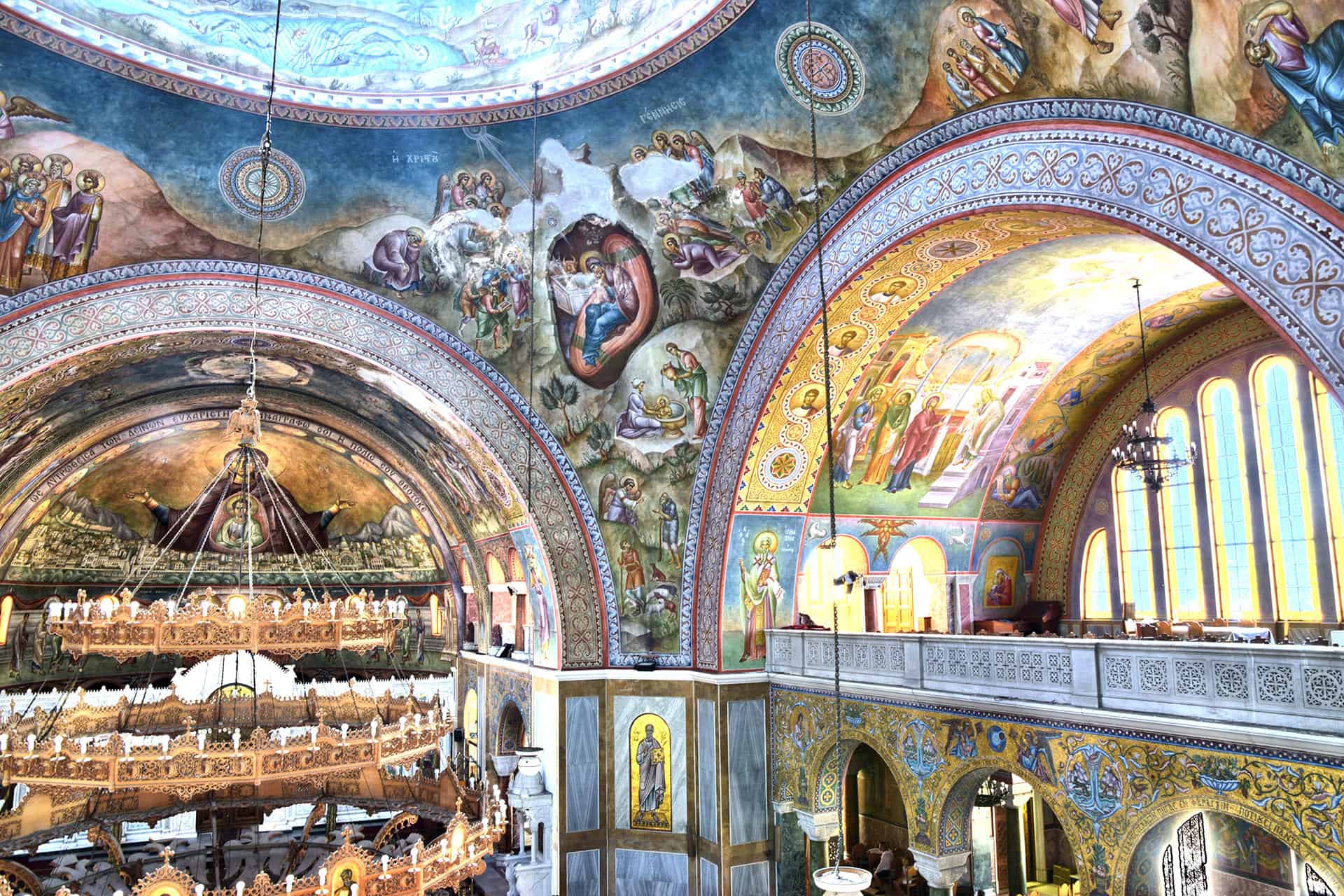
Barrel Vault
There are also three curved “side vaults,” essentially the three barrel-like, arched ceilings that overhang the galleries (“gynaikonitis”) plus a fourth-leading to the Apse. These were painted with depictions of the Birth, Ypapanti, Baptism, Lowering from the Cross, and Epitafio; and the Resurrection of Lazarus and Palm carriers. These were also done in the same style, colors, and method as the pendentives.
Blending and joining the paintings together are the decorative belts, or strips, with depictions of Saints, repeated rosettes and other attractive floral-like and geometric designs that serve as frames. The entire work is clearly executed by the same hand, in the same style, and with the same eye for symmetry, color, and attractive “whole.”
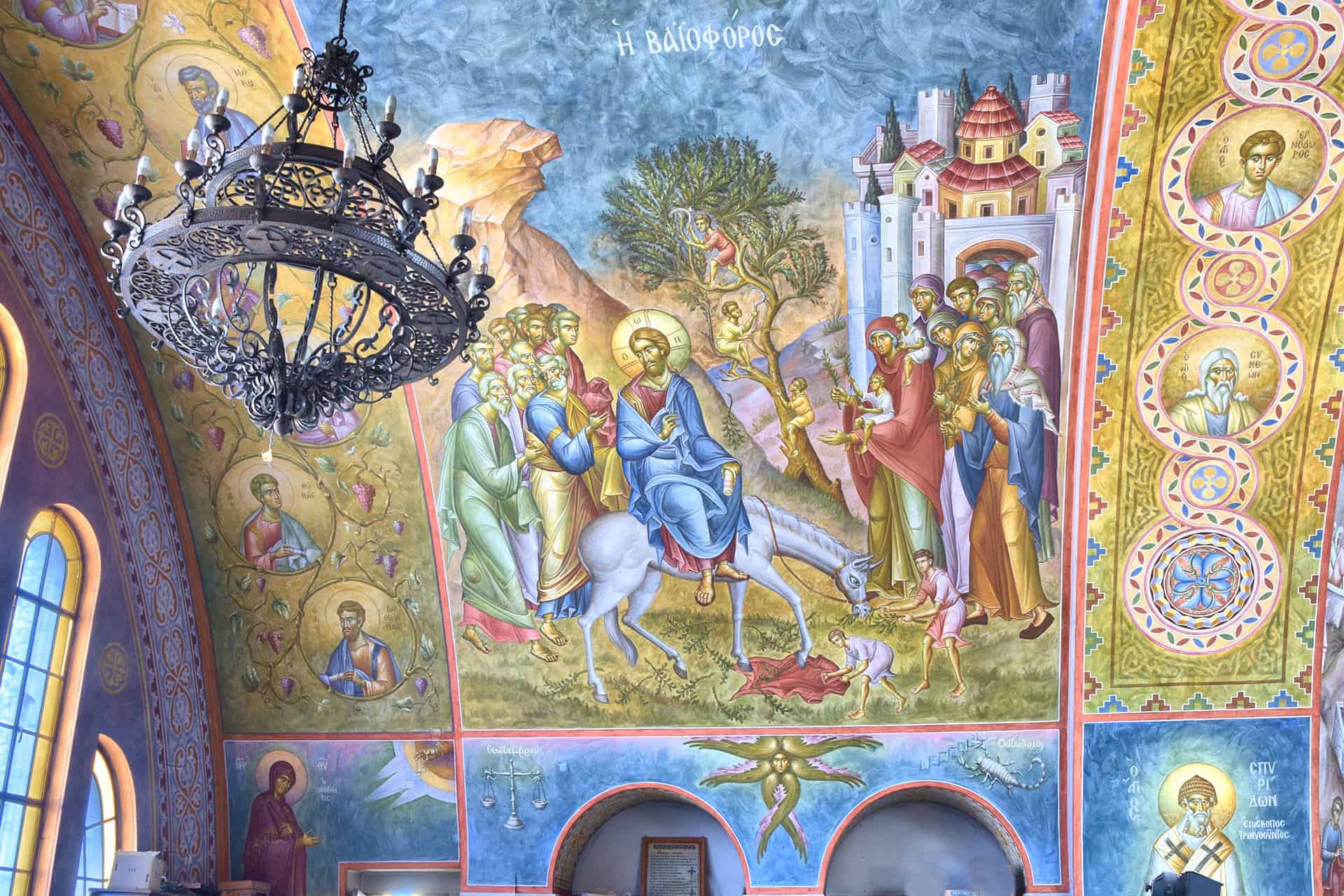
South Barrel Vault
When all the painting was completed, the total area was nearly 2,400 square meters (18,000 sq. ft.) It’s interesting to compare this figure with the painted area of the Sistine Chapel’s ceiling in the Vatican: Michaelangelo’s busy work covered 1,100 square meters or less than half of the space painted in St. Andrew. It took Michelangelo 4 years (1508-1512) to complete it, whereas Karousas did it in 7 (1985-1992) or actually in 5, because of a two-year hiatus 1991-1992. Both are impressive, outstanding works of art, even though one is currently more well-known.
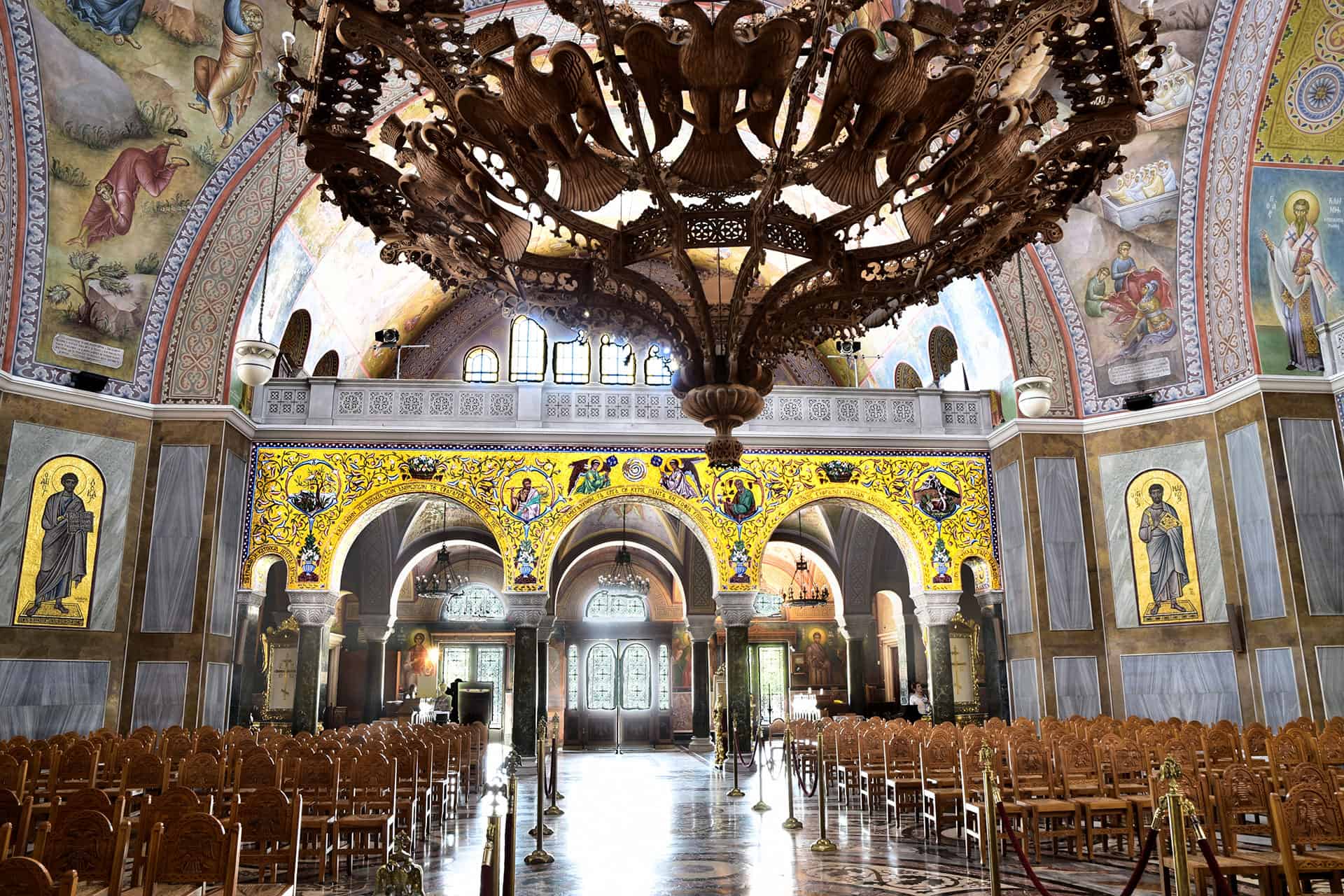
Main Entry
The entry and sides of the interior space are also of inspired design: there are dark marble colonnades on three sides of the nave, that support the upper galleries (the “gynaikonitis,”) whose carved capitals are inspired by those of Agia Sofia in Constantinople. Supported by these columns, the metopes glitter with gold mosaics, and aesthetic designs depicting the sea, boats, trees, birds, animals, entwined vines, and geometric designs, etc., intended to convey peace to the souls of the faithful.
As the sun traverses the sky, light from the doors and windows alternatively lights each gallery’s design, that sparkles with almost divinely-inspired brilliance.
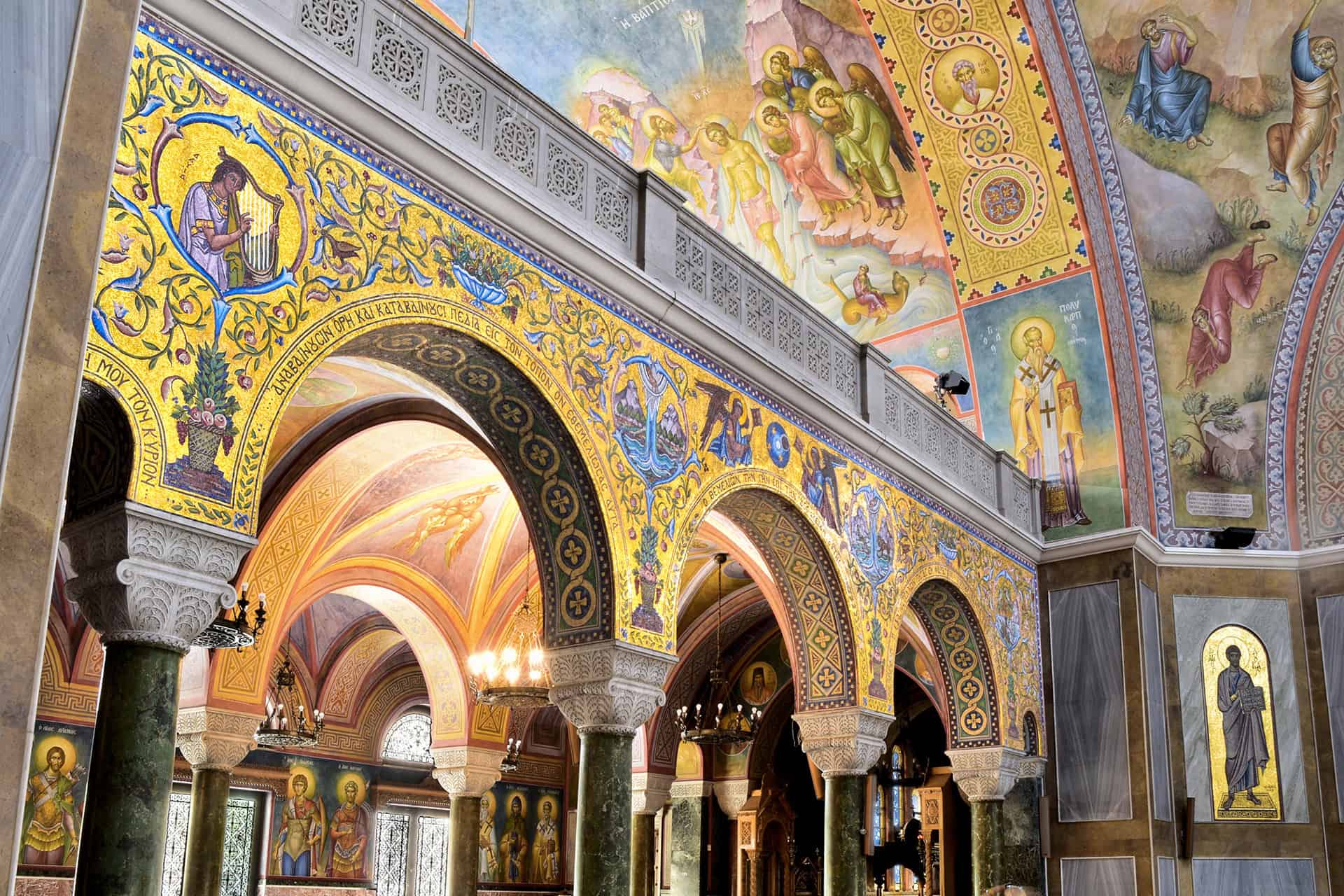
Metopes Supporting Galleries
The mosaics are the creation of the artist Katia Kolefa, who graciously acknowledged the assistance of her team of students, under the oversight of the committee. With their assistance, she executed the painstaking work of fitting the “tesserae” one by one to match the designs.
The work on the mosaics was started in 1995, with a target of 6 years, which was met, in 2000. Later, additional mosaic scenes, depicting the life and martyrdom of St. Andrew were created on the walls of the right side-isle, done from 2003 to 2006.
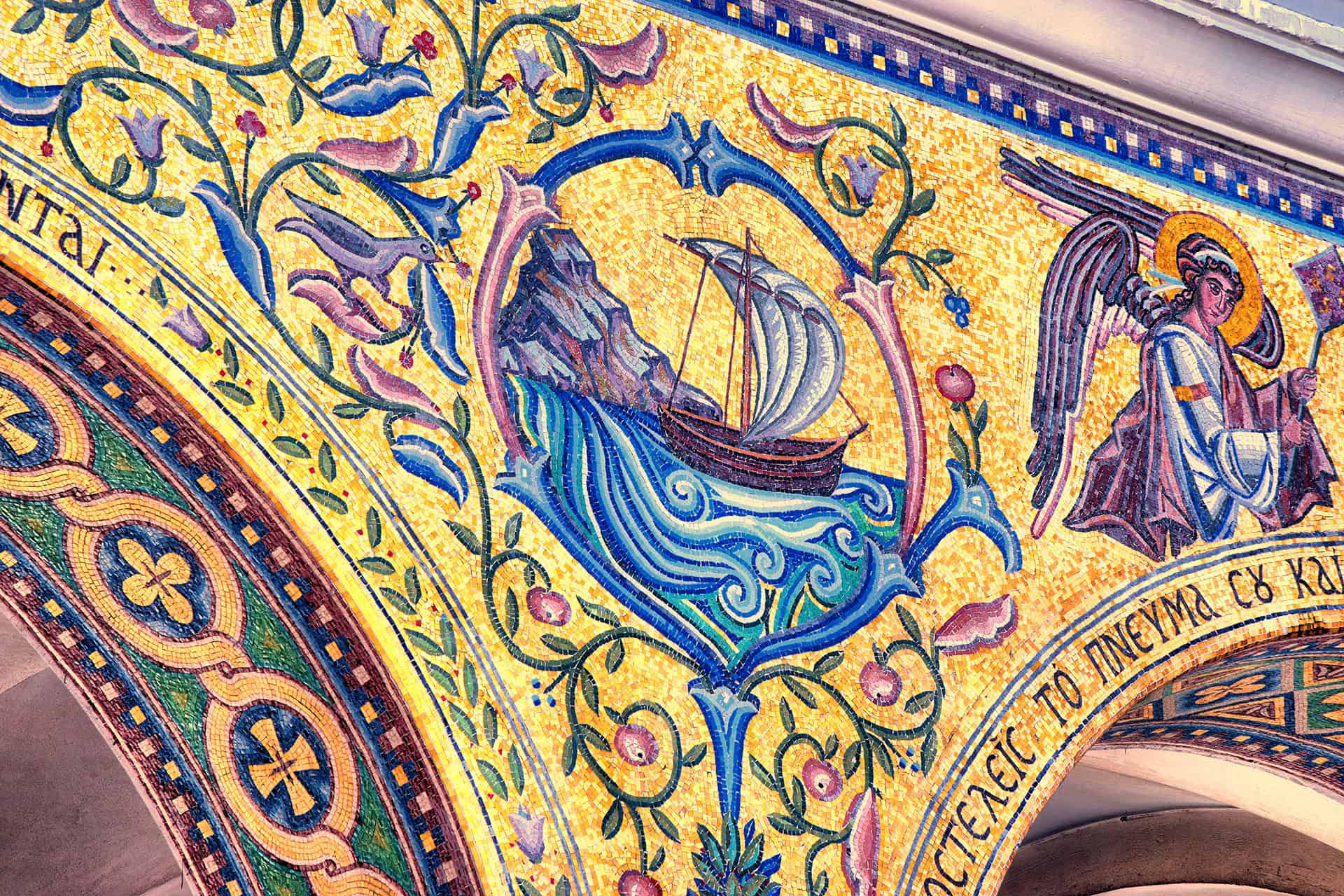
Detail of Metope Mosaics
The actual fabrication did not follow the traditional Byzantine “place-on-the-wall” design but instead used the Venetian technique, in which the mosaics were pre-fabricated in-reverse at the studio, and cemented right-side-out to the walls. They are equal, in quality and artistry, of the paintings, and enhance but do not overshadow the overall aesthetic effect of the Church interior.
A closer view of the details of the mosaics shows the meticulousness of the design, that adds a sense of comfort and serenity to the assembled faithful, and the stunning use of gold-colored tesserae.
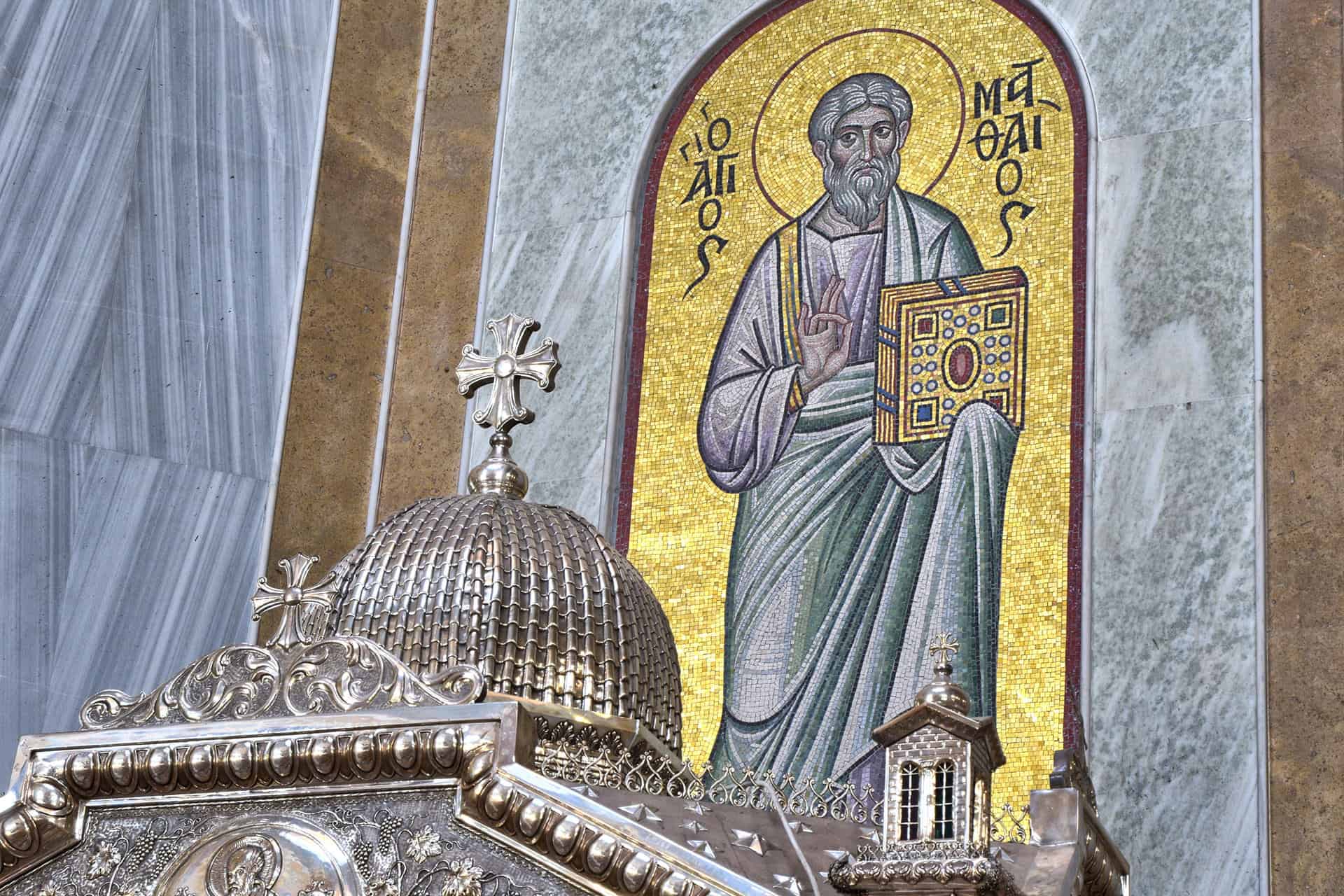
Saint Matthew
The mosaics depicting four saints (Mark, Luke, Matthew, and Theologos) each at the base of the four pendentives, together with the friezes above the colonnades give the Church a very rich, warm feeling of beauty and opulence, but despite their extraordinary size, (they total 140 square meters, or 1053 sq. ft.) they have the quality of a human-like scale.

The Marble Floor
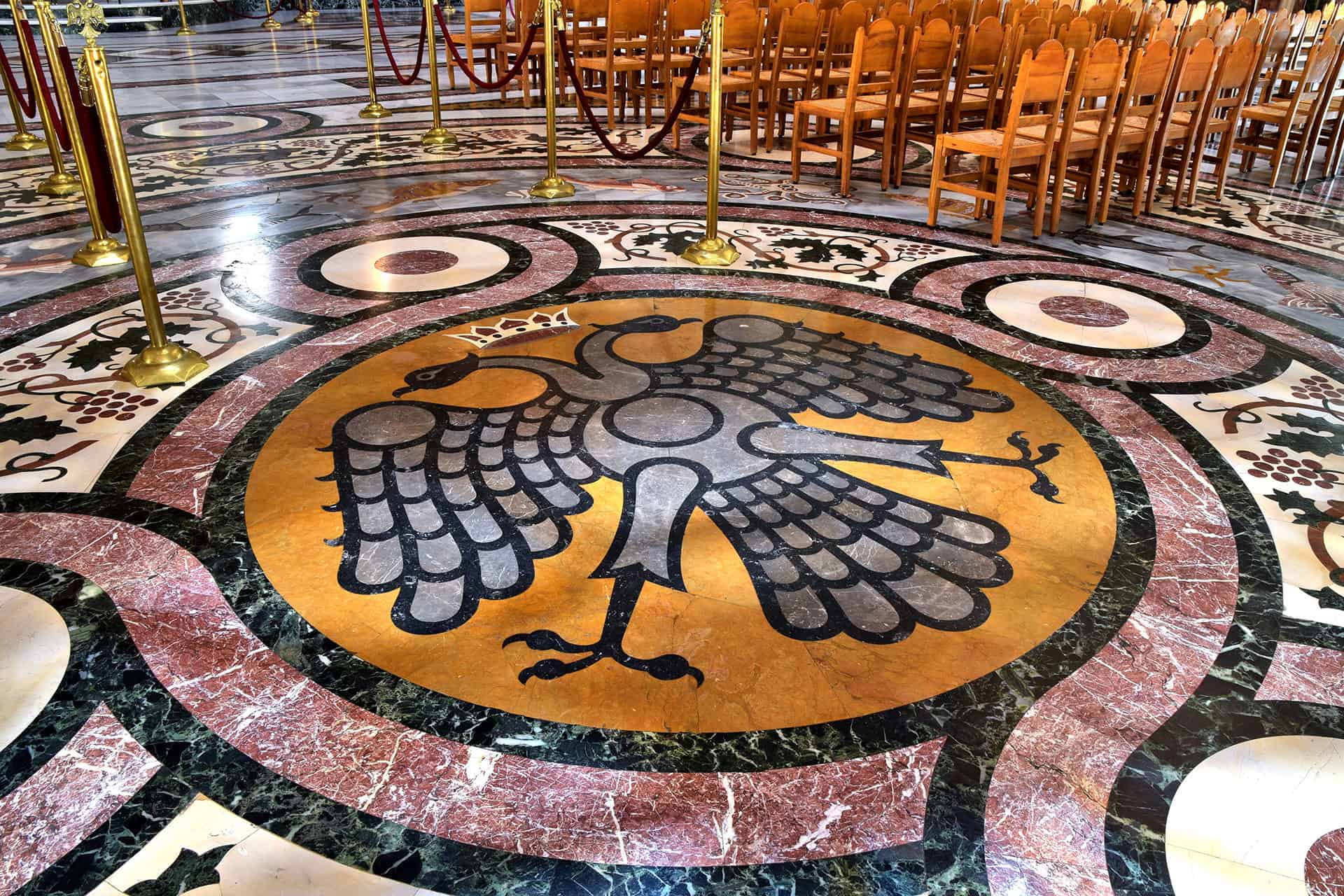
Floor Detail
Eventually, our eyes look down, at the floor. A perfectly aligned phalanx of movable carved wooden seats, with the Byzantine double-headed eagle on their backrest, stands on the marble floor. And what a spectacular floor it is! Mainly in colors to match the rest of the Church, at the center of the main aisle it again depicts, in very large diameter, the double-headed eagle, the traditional symbol of Orthodoxy, that dates from Byzantine times, surrounded by animals, birds, fish, and entwined plants, with decorative flourishes extending in all directions.

Chapel of Reliquary
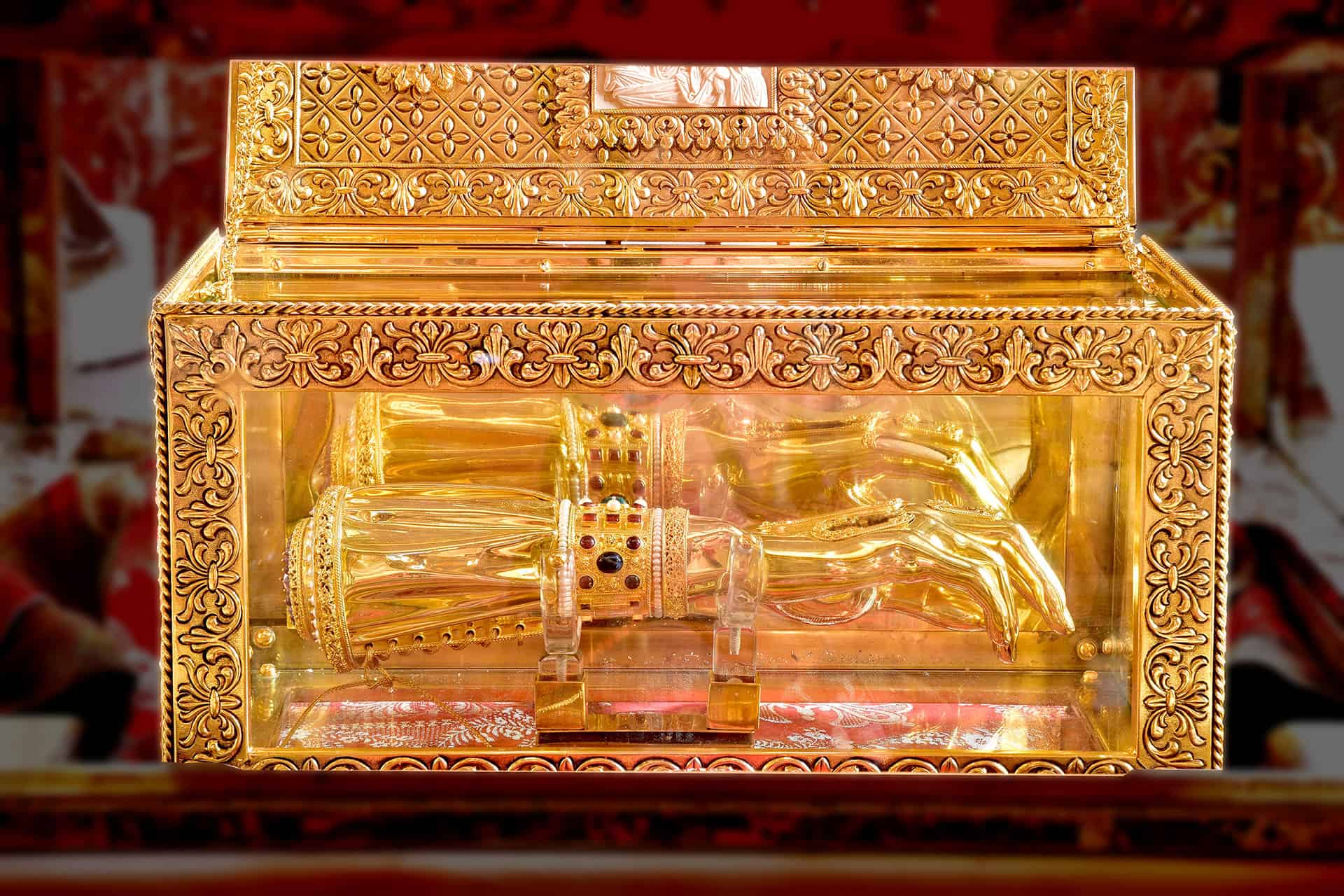
Reliquary – Bones of St. Andrew
But this is not merely a beautifully decorated building; it is a holy place intended to honor Saint Andrew, the Patron Saint of Patra. He was one of the twelve original Apostles, and brother of Saint Peter. The Church has anointed him with the name “first-called” because he and his brother were the first that Jesus called on to become his students and disciples. Andrew was martyred in Patra by the Romans. Indeed two chapels of the Church, at the ends of each side aisle, are the focus of the faithful: On the west aisle is the chapel where the mortal remains of Saint Andrew are placed, within two reliquaries. An ornate silver reliquary holds part of the skull of the Saint, and another, golden reliquary, holds bones of his hand.

X Cross Reliquary
On the East aisle is the chapel that displays an x-shaped frame, within which – behind glass – are remnants of the wooden cross upon which he was crucified. (Tradition has it that he was crucified in an “X” shaped cross.) – these Holy relics were acquired through long term efforts on the part of the clergy and the benevolence of the donors, after centuries of searches and negotiations, and effusions of goodwill.

Details – Painting and Mosaic
It took 66 long years to build the “New” Saint Andrews Church – a truly grand architectural design – and many more to complete its interior, which was done in a manner of such high artistic quality as to match the exemplary building. Not only is the artistry most impressive, but the quality of both chief artists, Ioannis Karousas for the paintings and Katia Kolefa for the mosaics, is well-matched in their vision and detailed execution, impeccably following the Byzantine tradition.
The artistic enrichment of the Saint Andrew’s Church is a truly magnificent statement of faith, love, and perseverance, a credit to Patra, its people, its clergy, its enlightened advisory council, to the artisans, and Orthodoxy everywhere.
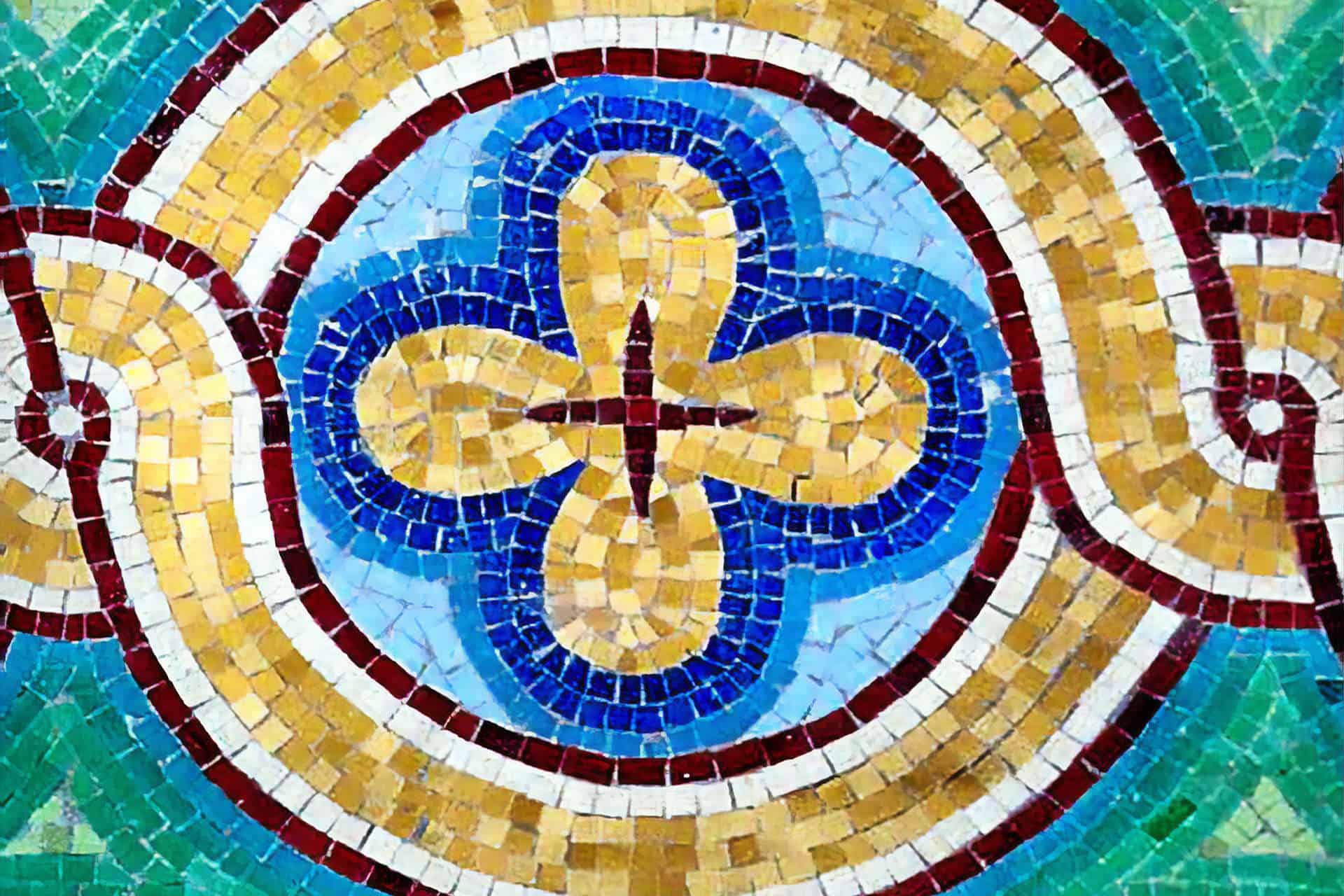
Detail of Mosaic
The most gracious assistance and support of the Senior Priest of St. Andrews, the Reverend Nikolaos Skiadaresis, is gratefully acknowledged.
